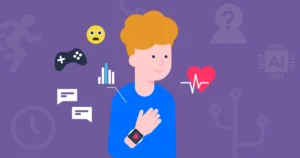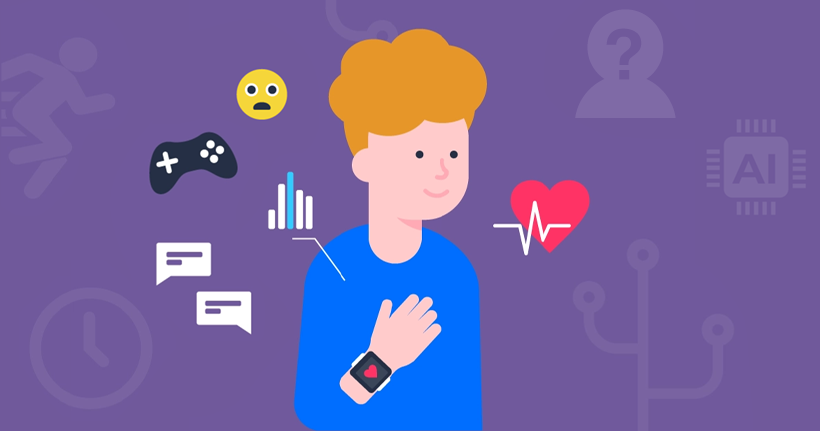What is wearable technology and is it safe for children?
Learn how wearable technology might impact children’s digital wellbeing, safety and security.

In this guide
- What is wearable technology?
- Is wearable technology safe?
- How wearable technology can support wellbeing
- 5 tips to use wearable technology safely
- Meet the experts
- Explore more Tech and Kids
What is wearable technology?
Wearable technology is any kind of device that you can wear on your body. Also called wearables, wearable technology can collect real-time data for any number of reasons.
Various types of wearable technology exist, including smartwatches, fitness trackers, smart glasses and more. Each device serves specific purposes depending on what it is.
Wearable artificial intelligence
Wearable artificial intelligence (AI) is an advancement in wearable technology. Essentially, wearable AI uses machine learning algorithms and AI-powered software to analyse collected data and give users personalised guidance.
For example, a wearable AI device that learns a users’ exercise habits can then suggest custom workout routines or dietary adjustments to help achieve fitness goals.
A major place where wearable AI comes into play is in healthcare. Monitors can collect vital signs data, detect problems and deliver real-time alerts to users and healthcare providers. Additionally, these devices can help doctors make more informed decisions by providing a view of a patient’s health over time.
For most people and especially children, the wearables they use will give limited lifestyle suggestions. However, it’s important for parents to research new devices and ensure the device is right for each user. This is especially important as wearable technology continues to develop.
Types of wearables
Smartwatches are popular among many people. They range in price and capability but can generally connect to the internet and your smartphone.
Some popular brands have smartwatches that connect easily to Android or Apple devices. These brands include:
- Samsung
- Google (including Fitbit)
- Apple
- Garmin
Fitness and health trackers can come in many forms. The most common is as a wristband or watch. These trackers collect health information, steps and more. When setting up these devices, they might require personal account information such as an email, location and more. Additionally, they often require information about a user’s age and physical health.
Fitness trackers also often come with apps that might include forums where users can communicate with others.
Wearable technology for medical purposes isn’t something new. In the 1980s, the first digital hearing aids and fitness trackers made their appearance. However, the pacemaker joined the scene even earlier in the 1960s to help treat abnormal heart rhythms.
Modern wearables for health continue to include hearing aids and pacemakers. However, they now also include:
- monitors;
- skin patches;
- glucose metres;
- biosensors.
Some items can monitor heart rate, sugar levels and more while others can collect health data for a user’s GP or administer medicine.
Smart glasses are devices you wear on your face like glasses. However, in your vision, you can see different apps and displays. Example of smart glasses include:
- Ray-Ban Stories and Ray-Ban Meta (released September 2023)
- Microsoft HoloLens (for business)
- Snap Inc. Spectacles (for Snapchat)
- Google Glass (discontinued March 2023)
In some cases, smart glasses might augment the user’s reality. Additionally, some companies might use smart glasses as a professional tool.
Learn more about learning through augmented reality in the metaverse.
What is smart jewellery?
Smart jewellery is a category of wearable technology meant to collect data while being discreet and fashionable. Devices are usually small — in the form of necklaces, tennis bracelets, rings and even earring backs.
Many pieces of smart jewellery won’t have a screen like with a smartwatch. Instead, users can view any collected data on their smartphone. Such data includes heart rate, sleep patterns, stress levels and more.
What are smart shoes?
While a young child might view light up shoes as the pinnacle of shoe technology, smart shoes can do so much more. Like fitness trackers, smart shoes can track steps. However, they can also measure the way someone walks or runs, where strains or other issues might occur and other really specific elements.
For a professional athlete or someone in physical therapy for mobility issues, smart shoes are a great option. However, they might not offer much to the average person.
Wearable technology in the form of safety devices might include GPS trackers, fall detection, panic buttons and more. They can come in a variety of forms, including necklaces, watches and helmets.
How do smart helmets work?
People who drive motorbikes or cycle might opt for a smart helmet instead of the standard safety item. They generally include a Bluetooth connection to the user’s smartphone. As such, smart helmets are a wearable technology that can track routes, make calls, play music and more. Some even have features to alert emergency contacts of accidents.
While smart helmets might seem useful, it’s not advised to listen to music while cycling or riding a motorbike as it could impact safety while moving.
VR headsets are a type of wearable technology generally associated with video games and the metaverse. Unlike other wearable technology, users only wear VR headsets whilst playing video games. They might require the use of games controllers and other types of wearable technology to move forward in the video game.
Hearables are a catch-all term for technology worn in users’ ears. They include Bluetooth headsets, wireless headphones and earbuds.
In most cases, this type of wearable technology works one-way such as connecting music from a smartphone. However, in some cases, such as with hearing aids or other medical devices, data is collected to share with a user’s healthcare professional.
Is wearable technology safe?
Wearable technology is often created for adults. As such, some features might pose potential risks for under-18s. So, when it comes to choosing the best device for your child, carefully consider the potential risks outlined below.
Privacy and data collection
Wearable technology collects and tracks user data, which is often what users want. Moreover, while something like a VR headset is unlikely to collect much data, a smartwatch or fitness tracker will.
The type of data collected varies. For devices that come with a companion app, users might need to sign up with an email, full name and birth date. However, other devices might not require any of that information.
Additionally, many wearable devices are designed for adults, not children. Therefore, the data collected requires adult permission and understanding.
If your child wants to use wearable technology, make sure you look into what data the device collects. Where possible, try to get devices made for children like, for example, the Fitbit Ace.
Impact on body image
While fitness and health statistics can support children’s fitness goals, it’s important to talk with them about what those numbers actually mean. In some cases, children and young people with body image issues might fixate on the data, misunderstanding what it means.
For example, many people agree we should get 10,000 steps per day. However, that’s not a number backed by medical science. As such, a child obsessing over their failure or success at getting a certain number of steps could lead to negative body image or low self-image.
If your child wants a fitness tracker or smartwatch, discuss their reasons and come to an agreement on what the use of wearable technology looks like for them.
Interacting with strangers
Many fitness trackers and similar wearables come with a companion app for the linked smartphone. Some of these apps have active communities that users can join. As such, users might compete or compare themselves with others.
If your child’s smartwatch or other device requires an app, check what these communities might look like. In some cases, you might need to set up privacy features to limit interactions with others.
Additionally, many fitness apps such as MapMyRun or MyFitnessPal connect to smartwatches. They might have their own communities users can interact with.
Make sure you review any app that connects to your child’s wearable and update relevant settings.
How wearable technology can support wellbeing
Movement and staying active, especially outdoors, bring many health benefits to an individual. As such, they can positively impact young people’s mental wellbeing from an early age, says Samsung.
“Our Samsung smartwatches try to enhance these benefits. For instance, the smartwatch can connect to other friends’ devices, allowing them to set fitness challenges between each other and also set team goals. The watch will also ping a reminder to start moving over periods of inactivity.”
How Samsung smartwatches support wellbeing
The Samsung Health app has several great features that could help with mindfulness and health. These include breathing exercises, improving healthy sleeping habits and tracking the duration and length of exercise activity.
Furthermore, our smartwatches can detect if the user falls, triggering a notification with a location to a pre-set contact. Additionally, there’s an option to select an emergency call option*. This is a potentially useful feature for children who walk independently to and from school.
Samsung smartwatches also come with an SOS feature. You can pre-set emergency contacts for your child. Furthermore, you can make medical information accessible to emergency services if needed and select whether or not to play a warning sound while the call is placed.
The activation of SOS alert varies depending on the models. Moreover, you can set a countdown before an SOS is sent in case of accidental initiation. This will set a five second delay to sending SOS messages and calls, allowing users to cancel.
*This notification is sent after the person using the watch has fallen and not moved for 1 minute. The information gathered from this device, Samsung Health or related software is not intended to diagnose, cure, mitigate, treat or prevent disease or other conditions. High impact activities can sometimes register as a fall.
5 tips to use wearable technology safely
Samsung says that while wearables are generally safe to use and there are many mental and physical health benefits, there are also risks.
As such, they advise that parents keep a close eye on their child’s wearable technology to ensure tracking and targets stay within healthy habits. The following questions can support parents and carers when it comes to wearables and safety.
Samsung smartwatches can track things like step count, sleep, stress, body composition, calories, weight and other fitness targets. While some children will view the data as a cool feature, other children might obsess over numbers due to body image or mental health issues.
Make sure you check-in regularly with how they use wearable technology to better support their wellbeing. Additionally, have regular conversations with them about why they track data, how they use it, what information it gives them and how it makes them feel.
Remind them that their health data is only a small part of the bigger picture; if it stresses them out or negatively impacts their mental health, it might be time to take a break.
While many children might use wearable technology like smartwatches, not all are designed with children in mind. As such, apps and accounts related to the device might require certain age minimums.
Samsung services, for example, are restricted to those 18 and over. However, users aged 13-17 can use Samsung services under the guidance of a parent or guardian.**
Whichever device your child uses, check the Terms of Service to ensure they are in compliance. This will help keep them safe in the digital space.
**By creating an account or using Samsung Services, you confirm that you accept these Terms. You also confirm that:
- You have reached the age of 18; or
- You are 13 or older but younger than 18 (“Minor”), that you have reviewed these Terms with your parent or legal guardian and that you and your parent or guardian understand and consent to the terms and conditions of these Terms. If you are a parent or guardian permitting a Minor to use the Services, you agree to: (i) supervise the Minor’s use of the Services; (ii) assume all risks associated with the Minor’s use of the Services, (iii) assume any liability resulting from the Minor’s use of the Services; (iv) ensure the accuracy and truthfulness of all information submitted by you or the Minor; and (v) assume responsibility and are bound by these Terms for the Minor’s access and use of the Services.
Many smartwatches, including those from Samsung, allow users to track their sleep. Doing this can help track sleep patterns and promote healthy sleeping habits.
However, wearing a smartwatch to bed might count towards your child’s screen time. As such, it’s important to discuss and set boundaries on what screen time might look like and where data tracking might sit.
Download the Digital Family Agreement to help set screen time boundaries.
Before your child uses a smartwatch or other wearable device, make sure it connects properly to the related smartphone. This ensures that if an emergency call needs to be placed, it does so correctly.
Additionally, you can require parent approval for all apps available on the phone, like Samsung Internet. Apps can be controlled or removed from the connected device.
With the optional fall detection feature available on Samsung smartwatches, contacts can be alerted in case of a fall. However, if the user falls accidentally but is fine, pre-set emergency contacts might worry that something is wrong, causing undue stress. Setting delays or turning off SOS calls can help reduce the chances of this happening.
When researching potential wearables, look out for what those safety features look like and consider how they might impact others.
Meet the experts

“Samsung truly believes that bringing tech to the forefront of education can open up many opportunities for young people – which is shown through our wider work across Solve for Tomorrow and our continued support of Safer Internet Day.” – James Kitto, Corporate Vice President, Samsung UK & Ireland
In partnership with Internet Matters, Samsung is committed to empowering parents to have the knowledge and tools to keep their children safe online throughout the connected home.
Our work together
Explore more Tech and Kids
Read more Tech and Kids guides to keep children safe with future technology.
 Close video
Close video
 Close video
Close video
 Close video
Close video
 Close video
Close video
 Close video
Close video





